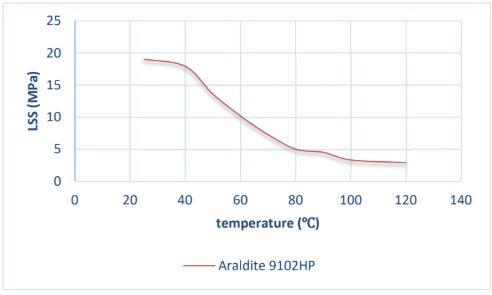Enhanced TDS
Identification & Functionality
- Chemical Family
- RTU Product Type
- Technologies
- Product Families
Features & Benefits
- Ready-to-Use Product Features
- Product Properties
- Multi-purpose & Bonds a wide variety of materials in common use
- Long work life
- Low shrinkage
- Good heat resistance
Applications & Uses
- Application Area
- Compatible Substrates & Surfaces
- Applications
- The resin/hardener mix may be applied manually or robotically to the pre-treated and dry joint surfaces.
- A layer of adhesive 0.05 to 0.10 mm thick will normally impart the greatest lap shear strength to the joint.
- The joint components should be assembled and secured in a fixed position as soon as the adhesive has been applied.
Lap shear strength versus temperature (ISO4587)

Technical Details & Test Data
- Cured Properties
Typical cured properties
Unless otherwise stated, the figures given below were all determined by testing standard specimens made by lap- jointing 170 x 25 x 1.5 mm strips of aluminium alloy. The joint area was 12.5 x 25 mm in each case.
Property Value Unit Test Method Condition Lap Shear Strength (Aluminum) 24 MPa ISO 4587 Cure: 70°C x 2 hrs, Test condition: 23°C, Pretreatment: Sand blasting
Lap Shear Strength (45# Steel) 28 MPa ISO 4587 Cure: 70°C x 2 hrs, Test condition: 23°C, Pretreatment: Sand paper abraded and isopropanol cleaning
Roll Peel Test 65 N*mm/mm GB/T 1457 or ASTM D1781-98 Cure: 70°C x 2 hrs
Glass Transition Temperature ca. 69 °C - Cure: 70°C x 2 hrs
Plane Tensile Strength (Aluminum) 3.5 MPa GB/T 1452 Cure: 70°C x 2 hrs
T-Peel Strength (Aluminum) 4.9 N/mm GB/T 2791 or ISO 11339 Cure: 70°C x 2 hrs
Tensile Strength 32 MPa ISO 527 Cure: 70°C x 2 hrs, Test condition: 23°C
Tensile Modulus 3200 MPa ISO 527 Cure: 70°C x 2 hrs, Test condition: 23°C
Elongation at Break 4.7 % ISO 527 Cure: 70°C x 2 hrs, Test condition: 23°C
- Processing Information
Pretreatment
- The strength and durability of a bonded joint are dependent on proper treatment of the surfaces to be bonded.
- At the very least, joint surfaces should be cleaned with a good degreasing agent such as acetone, iso-propanol (for plastics) or other proprietary degreasing agents in order to remove all traces of oil, grease and dirt.
- Low grade alcohol, gasoline (petrol) or paint thinners should never be used.
- The strongest and most durable joints are obtained by either mechanically abrading or chemically etching (“pickling”) the degreased surfaces.
- Abrading should be followed by a second degreasing treatment.
Mix Ratio
Parts by Weight
Parts by Volume
Araldite® AW 9102 HP CI 100 100 HW 9102 CI 45 50
Storage & Handling
- Storage and Handling Precautions
Storage
- Araldite® AW 9102 HP CI and HW 9102 CI must be stored at room temperature and the components must be stored in sealed containers.
Handling Precautions
- Our products are generally quite harmless to handle provided that certain precautions normally taken when handling chemicals are observed.
- The uncured materials must not, for instance, be allowed to come into contact with foodstuffs or food utensils, and measures should be taken to prevent the uncured materials from coming in contact with the skin, since people with particularly sensitive skin may be affected.
- The wearing of impervious rubber or plastic gloves will normally be necessary; likewise the use of eye protection.
- The skin should be thoroughly cleansed at the end of each working period by washing with soap and warm water.
- The use of solvents is to be avoided. Disposable paper - not cloth towels - should be used to dry the skin.
- Adequate ventilation of the working area is recommended.
Other
- Appearance
- Pale yellow
- Physical Properties
Value Units Test Method / Conditions Lap Shear Strength min. 20.0 MPa MPa Internal Method at 23°C Specific Gravity approx. 1.25 - Viscosity 20.0-35.0 Pa.s Pa.s ISO 3219 at 25°C
